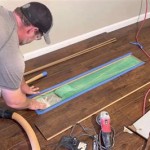Tongue and Groove Flooring for Porches: A Comprehensive Guide
Porches are often considered extensions of the home, providing a space for relaxation, entertaining, or simply enjoying the outdoors. Choosing the right flooring is crucial for creating a functional and aesthetically pleasing porch space. Tongue and groove flooring has become a popular choice for porches due to its durability, versatility, and attractive appearance. This guide outlines the key aspects of tongue and groove flooring for porches, covering its benefits, characteristics, and considerations for selection and installation.
Benefits of Tongue and Groove Flooring for Porches
Tongue and groove flooring offers numerous advantages that make it an ideal choice for porches. Its interlocking design provides several benefits:
Increased Stability and Durability:
The tongue and groove system interlocks individual planks, creating a solid and stable surface. This interlock prevents movement and warping, enhancing the flooring's longevity, particularly essential in outdoor spaces exposed to weather elements.Water Resistance:
Tongue and groove flooring can be made from various materials like hardwood, composite, or engineered wood. Many options offer inherent water resistance, making them suitable for porch environments prone to moisture. Proper sealing and maintenance are crucial for preserving the floor's integrity.Aesthetic Versatility:
Tongue and groove flooring comes in a wide array of wood species, styles, and finishes. This versatility allows homeowners to select a flooring that complements their porch design and personal preferences, adding a touch of elegance or rustic charm.Easy Installation:
While professional installation is recommended for optimal results, tongue and groove flooring's design simplifies installation. The interlocking system ensures a tight fit and allows for DIY projects.
Types of Tongue and Groove Flooring for Porches
Choosing the right type of tongue and groove flooring for your porch depends on factors like your budget, desired aesthetics, and the climate you live in. Here are some commonly used types:
Hardwood:
Traditional hardwood flooring, like oak, maple, or hickory, offers durability, elegance, and warmth. However, it requires regular maintenance and may not be suitable for all climates.Composite:
Composite flooring blends wood fibers with plastic or other materials, creating a durable and moisture-resistant option. It's often available in various colors and styles, mimicking the look of natural wood.Engineered Wood:
Engineered wood flooring combines layers of wood veneer with plywood or other core materials. This construction offers stability and dimensional stability, making it suitable for outdoor environments.Ipe:
Ipe is a naturally dense and durable hardwood known for its exceptional water resistance and long lifespan. It is an excellent choice for porches in harsh climates.Teak:
Another highly durable hardwood, teak possesses natural oils that repel water and insects, making it suitable for outdoor applications. Teak's distinctive reddish-brown hue adds a touch of elegance to porches.
Considerations for Selecting and Installing Tongue and Groove Flooring
When selecting and installing tongue and groove flooring for your porch, several factors should be considered:
Climate and Weather:
Your local climate will dictate the best flooring material. In humid or rainy areas, consider water-resistant options like composite or engineered wood.Traffic and Wear:
Porches with high foot traffic require durable flooring materials. Hardwood or composite options are generally more robust.Budget:
The cost of tongue and groove flooring varies depending on the material, thickness, and style. Consider your budget and prioritize durable, water-resistant options that align with your financial constraints.Subfloor Preparation:
A solid and level subfloor is essential for successful tongue and groove flooring installation. Repair any cracks or unevenness before laying the flooring.Installation Method:
Tongue and groove flooring can be installed using nails, screws, or adhesive. The chosen method depends on the material and subfloor type.
Tongue and groove flooring offers a versatile and attractive solution for enhancing porch spaces. By carefully considering the factors outlined above, homeowners can select the right type of flooring to create a functional and aesthetically pleasing porch that complements their home and lifestyle.

Tongue And Groove Porch Flooring Installation Guides

Tongue And Groove Porch Flooring Installation Guides

T G Porch Flooring Ett Fine Woods

Aeratis Traditions Porch Flooring

Tongue And Groove Floors Waterproof Composite Porch Floor

Tongue And Groove Porch Flooring Installation Guides

Azek Porch Tongue Groove Flooring To Replace Fir Remodel Wooden

Timbertech Advanced Pvc Porch Boards By Azek Decksdirect

Fixing A Rotten Tongue And Groove Porch Floor The Craftsman Blog

Wood Porch Flooring Tongue And Groove Decking
Related Posts








